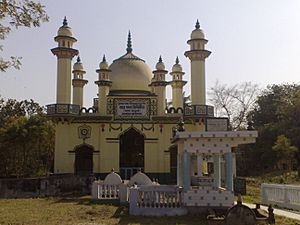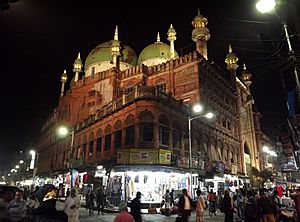Mohammad Abu Bakr Siddique facts for kids
Quick facts for kids Mohammad Abu Bakr Siddique |
|
|---|---|

Shrine of Abu Bakr Siddique
|
|
| Religion | Islam |
| Denomination | Sunni |
| Order | Furfura Sharif |
| Alma mater | Hooghly Madrasah |
| Personal | |
| Born | 15 April 1845 Furfura, Hooghly district, Bengal Presidency |
| Died | 17 March 1939 (aged 93) |
| Resting place | Furfura Sharif |
| Children | 5 sons |
| Parents |
|
| Relatives | Abbas Siddiqui (great-grandson) Nawsad Siddique great-grandson) |
| Senior posting | |
| Successor | Abdul Hai Siddique |
| Religious career | |
| Teacher | Jamaluddin, Bilayet, Amin Ridwan |
| Disciple(s) | Nesaruddin Ahmad Muhammad Shahidullah |
| Works | Ilm Ma'refat and Service of Shari'ah |
Mohammad Abu Bakr Siddique (born April 15, 1845 – died March 17, 1939) was an important Islamic scholar from Bengal. He was the first Pir (a spiritual guide) of Furfura Sharif in West Bengal. Many people in eastern India and Bangladesh saw him as a mujaddid, which means a reviver of Islam. He helped spread Islamic teachings by building many mosques and madrasas (Islamic schools). He also started newspapers and worked to improve education in areas that needed it most.
Mohammad Abu Bakr Siddique was also the first president of a group called Anjuman-i-Wazin-i-Bangla. This group supported important causes like the Khilafat Movement and the Pakistan Movement. His resting place in Furfura Sharif is a very respected Sufi center in West Bengal.
Contents
Early Life and Family Background
Mohammad Abu Bakr Siddique was born on April 15, 1845. His family lived in a village called Furfura, in the Hooghly district. His father, Haji Abdul Muqtadir Siddiqui, was a mawlana, which means an Islamic scholar.
His family believed they were descendants of Abu Bakr, who was the first leader (Caliph) of Islam after Prophet Muhammad. Mohammad Abu Bakr Siddique's father passed away when he was only nine months old. So, his mother, Mohabbat-un-Nesa Begum, raised him.
His Education Journey
Mohammad Abu Bakr Siddique started learning at home around 1850. After learning basic Islamic knowledge, he went to a local primary school. He thought about studying other subjects, including English.
One night, when he was a child, he had a dream. In his dream, the Prophet of Islam, Muhammad, told him to focus on religious studies. After this dream, he left his other studies. He then joined Sitapur Madrassah, an old school that started in 1772 near Furfura.
After finishing his first studies there, he went to Mohsinia Madrasa in Hooghly city. He did very well, getting first place in the highest class.
Later, he moved to Kolkata city. He joined the Jamaluddin Education Center. There, he studied Hadith (sayings of Prophet Muhammad), Tafsir (explanation of the Quran), and Fiqh (Islamic law). His teacher was Jamaluddin Mungeri. He also studied Hikmah (wisdom) and philosophy with Nazar Shah Belayati. While studying with Belayati, he stayed at the Nakhoda Mosque.
After finishing his formal education, he spent 18 years researching different parts of Islam. During this time, he created his own library. It had many rare and special books. This library is now part of the Furfura Fatehia Senior Madrasah, a school he later founded. In 1892, he traveled to the holy cities of Mecca and Medina. In Medina, he received a special certificate for studying 40 Hadith books.
Helping Education Grow
Mohammad Abu Bakr Siddique did a lot to help education. He established 1100 madrasahs (Islamic schools) and 700 mosques. The madrasahs he started in his own village became very important schools in India. Even Haji Shariatullah, who started the Faraizi movement in East Bengal, came to Furfura to learn Arabic and Persian.
In 1928, he became a member of the managing committee for Calcutta Alia Madrassah.
His Knowledge of Hadith
M. Obaidul (1903-1984), who was the principal of Feni Alia Madrassah in Bangladesh, said about him:
"ইলমে জাহের ব্যতীত আল্লাহ তাকে ইলমে লাদুন্নিও (আল্লাহ প্রদত্ত বিশেষ জ্ঞান) প্রদান করেছিলেন। তিনি ফলে কুরআন, হাদিস ও ফিকহের, ও ইসলামের মারেফতি শিক্ষার গভীরে জ্ঞান অর্জন করেছিলেন। বিশেষ করে তিনি হাদিস শাস্ত্রে অভূতপূর্ব জ্ঞান অর্জন করেছিলেন, যার জ্ঞান সারা উপমহাদেশে ছড়িয়ে পরেছে।
Allah gave him special knowledge, beyond what he learned from books. Because of this, he gained deep understanding of the Qur'an, Hadith, Islamic law, and spiritual teachings. He had amazing knowledge of Hadith, and his wisdom spread across the entire region.
During his time, Hadith was not taught at Alia Madrassah. He started this system. Teaching Hadith began in 1902 at the Kolkata Ghaspatti Mosque. He himself taught Hadith there. Many scholars learned Hadith from him.
Spiritual Journey
Mohammad Abu Bakr Siddique learned two ways to feel closer to Allah: jizba and suluk. People say that during his student days, he had special spiritual experiences. He was a khalifah (a spiritual successor) of Fateh Ali Waisi.
His Impact and Influence
In the late 1800s, some Islamic movements became less strong. Muslims faced many challenges and divisions. Mohammad Abu Bakr Siddique was worried about this. He wanted to bring Muslims together. He worked hard to remove wrong beliefs and superstitions from Bengal.
Many scholars helped him in this important work. Some of them were Shamsul Ulama Ghulam Salmani, Allama Lutfur Rahman Burdwani, Allama Ishaq Burdwani, Belayat Hussain Birbhumi, Abdul Wahid Chatgami, and Muhammad Mangalkoti Burdwani. Abdul Awwal Jaunpuri and Karamat Ali Jaunpuri also helped spread Hadith teachings. They were both influential writers.


